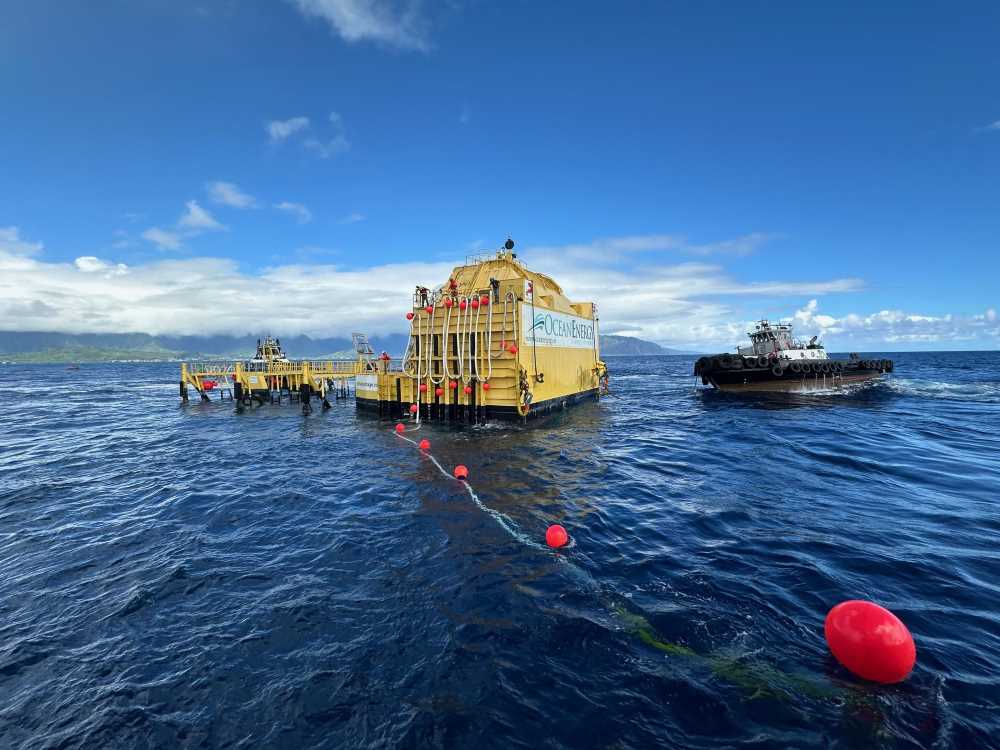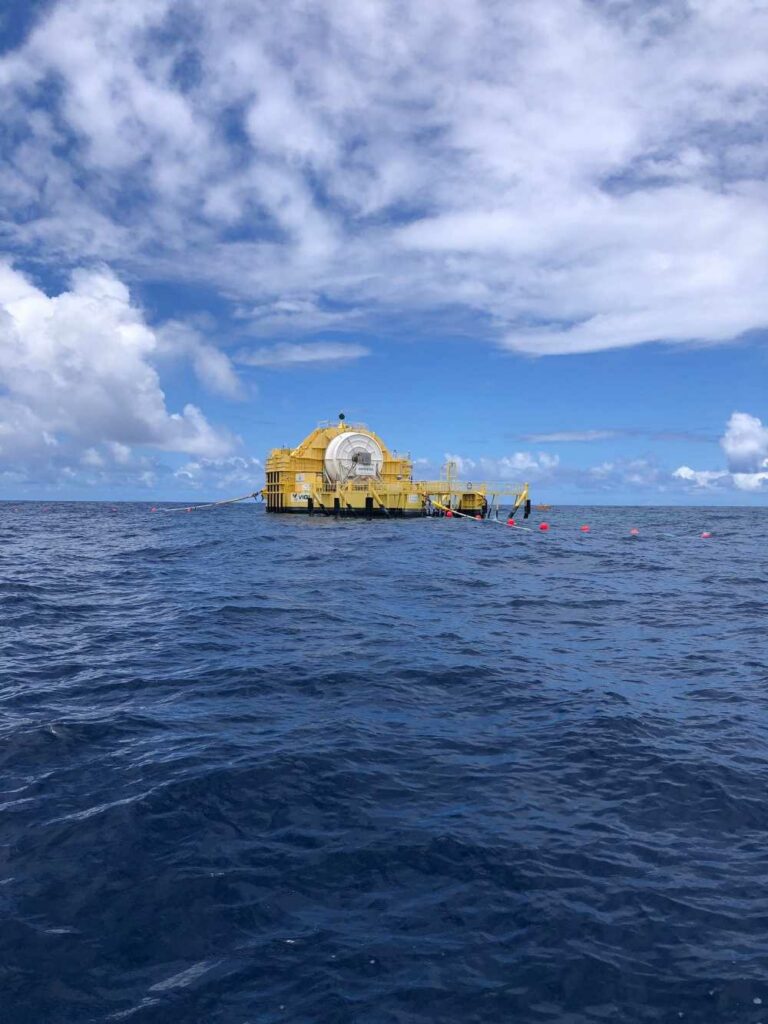
Posted on 07/30/2024 7:57:48 AM PDT by Red Badger

Image Credit: Ocean Energy USA LLC
=====================================================================================
The world’s first-ever grid-scale wave energy device has been installed at the US Navy’s Wave Energy Test Site (WETS) on the windward coast of the Hawaiian Island of Oahu.
Funded by the US Department of Energy and developed by the Irish energy company Ocean Energy USA LLC, the massive energy harvesting device they call OE-35 is designed to capture the energy generated by ocean waves, sometimes referred to as “blue energy,” and convert it into usable electricity.
The novel power generator will undergo several tests before being connected to the Hawaiian energy grid. Once connected, it will represent the largest wave energy harvesting device currently in use anywhere in the world, according to a press release announcing the placement of OE-35.
“Following over a decade and a half of design, trials, testing, and building, we are excited finally to be able to take this major step towards commercialization with our world-class OE-35 device,” said Professor Tony Lewis, Ocean Energy’s Chief Technology Officer.
Wave Energy Harvesting Seeing Renewed Interest While renewable energy technologies like solar and wind power have outpaced the alternatives, the ability to capture the energy generated by ocean waves and convert it into electricity was first tested in the mid-twentieth century. Unfortunately, low performance and difficulty in placement and use have limited its adoption compared to land-based energy solutions.
More recently, renewed interest in wave energy harvesting, especially in coastal locations, has begun to drive improvements. Earlier this year, The Debrief reported on a wave energy harvesting “hack” developed by scientists that improved the performance of standard triboelectric nanogenerators (TENG) simply by repositioning the electrode within the device. That work showed increases in energy output over previous designs, ranging from 2 to 3.5 times.
In China, another team of researchers used TENGs to develop a “rain panel” that generates electrical energy from the impact of raindrops on its surface. While not commercially available, these types of devices could offer a whole new way to capture and use energy.

Image Credit: Ocean Energy USA LLC
OE-35 Potential rated Capacity of 1.25 Megawatts
================================================================================
Unlike some other wave energy harvesting systems, which are comprised of a chain of smaller modules, the OE-35 is a single, massive 826-ton wave energy converter buoy. According to details released by the company, the OE-35 measures 125 x 59 feet with a draft of 30 feet. When operating at full capacity, this first-of-its-class energy harvester boasts a “potential rated capacity” of 1.25 megawatts.
For its current round of testing, the offshore device is located north of Mōkapu Peninsula, at the WETS site in Kaneohe Bay, after it was towed from Honolulu on Friday, July 19. While few details are available on the nature of the system’s upcoming tests, the company did say once they have determined it is ready for deployment, they plan to connect it to the Hawaiian energy grid via undersea cables “in the coming weeks.”
Funded by the US Department of Energy’s Office of Energy Efficiency and Renewable Energy and the Sustainable Energy Authority of Ireland (SEAI), the $12 million project is hailed by the company as a major step forward for renewable energy harvesting. If it passes the test, it will be the first grid-scale system using this technology to be deployed. It could also represent an enticing new option for governments and companies looking to generate power with a much lower carbon footprint than traditional power generation technologies.
“This internationally significant project couldn’t come online at a more critical time for the US and Ireland as the World needs to accelerate the pace of decarbonization with new and innovative technologies,” said Lewis.
Those had better be some serious chains and anchors.
Does being bigger make it more durable than smaller units, when you include all possible costs, which includes replacement costs?
Will it screw up the surfing?
Junk to clutter up the ocean.
Will they ever stop with this insanity.
Build nukes!
Waves run all the time, unlike solar or wind.
There is a lot of potential for a system like this in remote areas of bases.
Modern small modular-capable nuclear energy power-plants are a much better idea.
Everythig natural in nature - the wind, the waves, the sun is important to how the world works. How much energy can you “harvest” from them before you alter the way they work.
Do giant wind farms alter the winds?
Does “harversting” energy from waves, alter ocean currnts by the degree their energy has been reduced?
How cooler would the world get if solar arrays captured 100% of the electricity needed for everything?
Just asking.
Oh finally! The government’s price was finally revealed in the last paragraph of this piece of publicity stunt: 12.5 million for a single “potential” 1.25 Megawatt offshore generator.
No connection to shore power. No cabling, Tidewater access roads and towers. Transformers and rectifiers or inverters or battery storage devices so what little energy is created at random tides can be provided “when it is actually needed” back on shore.
I have worked on pump motors bigger than 1.25 Megawatt. Worked on local ponds with 1930-era hydrogenerators in a mill pond of 12 Megawatt capacity. Ten times this thing.
And you can fish or swim in that little lake under the trees.
So considering it probably won't average its potential, it will power about 700-800 homes.
Not bad. I wonder what is its total cost per KW hour?
I wonder if it would be more efficient if put in a shallower spot, where the wave amplitude is higher, or maybe the reverse it true.
This makes a lot more sense than capturing energy from radio waves. There is actually some real energy here.
Expecting to produce enough power to charge a cell phone.
If it truly works, the Green Weenies will come up with an endangered jellyfish to stop it from being used..............
You are not allowed to ask that question. Don’t do it again.
Think of a power plant for mobile dry docks during a war.
>>When operating at full capacity, this first-of-its-class energy harvester boasts a “potential rated capacity” of 1.25 megawatts.
IIRC, the smallest nuke reactor in the US has a generating capacity of 582 megawatts. since the “potential rated capacity” is the unattainable happy case, I wonder what the “actual” capacity of this generator is going to be, and through how much of the year it will be able to run.
The salt water impact on all ocean based generating equipment is significant. Tidal and wave forces are unceasing, that is true, but the equipment life would be very compromised by sea water in every case. The MARS project off Venice is a good example and it doesn’t generate any energy.
Given a -3dB rule of thumb, I’d say about 600 kilowatts.................

![]()
Disclaimer: Opinions posted on Free Republic are those of the individual posters and do not necessarily represent the opinion of Free Republic or its management. All materials posted herein are protected by copyright law and the exemption for fair use of copyrighted works.